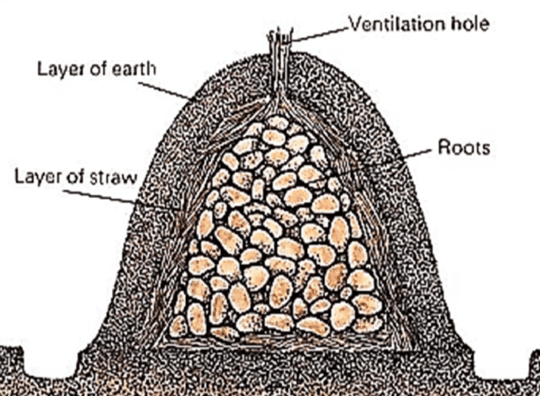تقنيات تخزين وحفظ المحاصيل الزراعية في المغرب/ تأليف: أليسا أندروود, Al Bayader.
By Alyssa Underwood
Farmers employ a variety of post-harvest crop storage to protect crops from post-harvest damage. Many of the methods employed in developing countries and on small-scale farms are traditional methods that use local resources. Modern storage methods use modern technology to protect crops. Post-harvest storage of horticulture crops is an important practice for small scale farmers to protect their crops. Traditional storage methods present an effective alternative to costly modern methods of storage in mitigating the effects of post-harvest crop damage.

Illustration of clamp crop storage (SOURCE)
Post-harvest crop damage is anything that damages the crop and keeps it from human consumption. It can be caused by insects, pests, microbes, and storage at improper humidity and temperature. Additionally, humans can cause post-harvest damage by mishandling the crops. Proper storage of crops post-harvest can decrease the threat of damage by isolating the crops from pests and microbes, as well as keeping crops temperature and humidity controlled to slow natural ripening processes.
Post crop harvest damage presents a large threat to agricultural profits. Post-harvest damage causes 50 percent of horticultural products to be lost. Annual crop losses in Sub-Saharan Africa are equivalent to the loss of 4 billion USD. Fourteen percent of the Moroccan GDP is from agriculture, and horticultural crops comprise 85-90 percent of Moroccan market products. Therefore, proper storage practices are crucial to increasing the profitability of Moroccan farms. Farmers in one-fourth of developing countries use community level crop storage. If the storage at this level is not carried out effectively, small scale farmers could lose entire crops and their sources of income.

Illustration of evaporative storage (SOURCE)
Traditional methods of horticultural crop storage employed on small scale farms are pits, clamps, cellars, zero energy chambers, and natural ventilation structures. These structures are generally used by small scale farmers because they employ local materials and store smaller quantities of food at a time. They are also cost effective alternatives to large, refrigerated warehouses. Pits are holes that are lined with straw or sand and use the natural coolness of the ground to keep the crops refrigerated. They are typically placed in areas of high elevation to avoid flooding due to rainfall. Clamps use straw and soil to insulate the crops. The horticultural crops are piled in a field and then covered with straw, followed by a layer of soil. Cellars are cool, dark, damp rooms that have enough ventilation to keep the humidity at the proper level. Cellars can be constructed as basements below existing buildings, built into the side of a hill for maximum drainage, or built as an aboveground structure covered by rocks and sod.

Illustration of pit crop storage (SOURCE)
Zero energy chambers employ evaporative cooling to keep crops cool. When water evaporates, it cools the surface with which it was in contact. These structures use double brick walls, soaking the inner brick with water to keep crops cool. These can reduce the temperature by 10-15 degrees Celsius and keep humidity levels at 90 percent Finally, natural ventilation structures are constructed to maximize airflow to ensure the heat and humidity generated by the crops is removed. These structures are not well equipped to keep out pests, however spraying the crops can mitigate pest damage.
Modern storage structures employ the use of technology to control the temperature and humidity of crops. These methods are higher cost and less environmentally friendly. Cold storage is the process by which the temperature of an area is cooled to slow the cellular respiration of the crop. The lowered temperature is accomplished using refrigerants and well insulated buildings. A cold storage unit can cost as much as 170 USD per square foot. A Dutch study found that Morocco has great potential for cold storage development, as much as 1,700,000 m3. Additionally, hypobaric storage can be employed to reduce respiration of crops by keeping the atmospheric pressure low and decreasing the amount of oxygen in the environment.

Cellar crop storage (SOURCE)
Traditional methods of crop storage are effective for the short term storage of crops in high temperature arid regions like Morocco. These methods utilize low cost materials that can be found on many farms, often repurposing materials that would otherwise go to waste. They are cost-effective methods of preservation that require little input and enable the majority of the profit from the sale of horticultural products to be retained by the farmer. Many Moroccan farmers operate on fewer than five hectares of land and are economically vulnerable. These traditional methods of storage present crop protection options that don’t require major up front investment. More technological methods, like refrigerated warehouses, are better for long term storage. These methods have greater control over the storage environment and increase the adaptability of the preservation of horticultural products. However, these methods are more costly as they require materials that are not local and require the input of energy.

Ventilation storage (SOURCE)
Post harvest crop storage is key to maintaining the profitability of agriculture. Farmers can employ many methods to keep their crops safe. Traditional methods are less costly, but do present greater risk of crop loss. Modern methods of storage are more costly, but enable more control over the conditions in which the crops are kept.
The United States Agency for International Development’s Farmer-to-Farmer Program that is implemented by the High Atlas Foundation in Morocco is in a position to assist agricultural cooperatives and education centers in evaluating effective approaches to storing yields. It is a volunteer initiative that currently connects local and American experts as they share techniques that are then transferred to Moroccan agriculturalists. They are also committed to empowerment and follow-up which help to ensure the sustainability of community projects.

Illustration of zero-energy storage (SOURCE)
Alyssa Underwood is a student of Global Studies at the University of Virginia in the United States.
